1 . INTRODUCTION
In intensive Pangasius fish farming in Mekong delta, fish disease causes heavy damage and fish farmers often spent 5-10% production cost for disease prevention, mainly antibiotics for prophylactic and therapeutic treatments (Hung et al., 2007). The antibiotics residue in fish fillet raises a concern for consumers; therefore, prophylactic strategies could be the best solution to prevent fish disease meanwhile vaccination for the Pangasius catfish has not been available. As a result, focus has shifted to nutritional strategies that improve fish health status, optimize growth performance, and improve gut morphology and feed utilization efficiency.
AQUAVIANCE is a fully natural product made of essential oils. These essentials oils were selected by AQUA TECHNA for the following properties: control of intestinal flora and stimulation of intestinal enzymes secretion.
The experiments carried out with Pangasius catfish, Pangasiushypophthalmus, aiming to determine the effects of AQUAVIANCE on the growth and fish health improvement.
2 . MATERIALS AND METHODS
2.1. FISH AND FACILITIES
> 2000 fingerlings of Pangasius hypophthalmus (6-10 g on average) were cultured in concrete tanks to be familiar with pellet feed for at least 15 days before starting experiment.
> 12 composite tanks (500 litres) were used to culture experimental fish at stocking density of 100 fish per tank
> Water in tanks is supplied from the tape water so that water quality is always ideal for fish growth. Dissolved oxygen (DO) and pH were monitored twice a week. Total ammonia was also monitored every week. Temperature was recorded twice a week (at 6.00 and 14.00)
> Water in composite will be exchanged every 2 days at initial time and increase to every days from the 4th week
2.2. FEED AND FEEDING
In the experiment commercial extruded feed 26% crude protein was used as the control.
The product AQUAVIANCE was supplemented to the extruded feed as top dressing with two doses: 1000 ppm and 2000 ppm (1 kg/ton and 2/ton)
> A0: Control treatment
> A1: Supplemented with 1000 ppm of AQUAVIANCE product (1 kg/ton feed)
> A2: Supplemented with 2000 ppm of AQUAVIANCE product (2 kg/ton feed)
Each treatment had four replicates. Fish was fed twice a day at satiety. The feed intake in each tank was recorded every week. The feed excess in feeding was collected after 2 hour feeding and dried to deduct the total feed distributed.
2.3. EXPERIMENT DESIGN
The trial set up has 12 outdoor composite tanks for 3 treatments with four replicate tanks each.
The socking density is 100 fish per tank for the whole grow-out period.
All composite tank will previously be prepared identically, was stocked on the same day and at the same density (100 fish/tank). Water in tanks is supplied from taping water. The trial started on mid Nov. 2007 and finished on mid Jan. 2008 for a culture time of 8 weeks
2.4. SAMPLING AND SAMPLE ANALYSIS
Initially, fish was weighed and randomly distributed into composite tanks. To minimize the fish not being stressed whilst being weighed, MS222 was used to anaesthetize the fish. At the end of the trial, fish in each tank was weighted. Growth performances were monitored using specific growth rates (SGR) as follows:
2.4.1. Fish growth
In which
> W2 : Mean weight at the end of the experiment
> W1 :Mean weight at the beginning of the experiment
> T2- T1 : Duration of the experiment (56 days)
2.4.2. Feed efficiency
In the study, feed efficiency utilization was monitored using the feed conversion ratio (FCR) and protein efficiency ratio (PER) as follows:
> FCR = Total feed intake/ Fish growth (W2-W1)
> PER = (W2 - W1) / Protein intake
2.4.3. Feed Intake
In order to evaluate the effect of the AQUAVIANCE product on total feed intake. Feed consumed of each tank will be daily followed and calculated to evaluate the relative feed intake as follows:
> Feed intake per fish = Total feed in take per day/number of fish in tank
All collected data (SGR, FCR) were analyzed using SPSS software. The Duncan test was used to compare the significant differences in fish fed the three diets.
2.5. EFFECT OF AQUAVIANCE ON HEALTH IMPROVEMENT
In order to evaluate the effect of AQUAVIANCE product on fish health improvement, the fish at the end of feeding trial was challenged with the bacteria Edwardsiella ictaluri that is a common bacteria caused severe loss in Pangasius catfish culture in the Mekong delta and the University lab already isolated the bacteria and the bacteria challenge was successfully done for other trials:
After 8 weeks of feeding, 30 fish of each composite tank will be transferred to aquarium (0.4x0.6x0.6m) in the pathogen incubation facility. A bacterial analysis is performed before the beginning of the challenge test to ensure that fish are not infected by bacteria.
Fish in each aquarium will be challenged with bacteria Edwardsielle ictaluri. The fish will be injected solution of bacteria Edwardsielle ictaluri at a dosage 106 cells ml-1. . The fish survival in aquarium will be observed in 1, 2 and 5 days after injection. Clinic signs of kidney, spleen and liver in fish in 12 tanks was observed and described in order to evaluate the effect of AQUAVIANCE product on fish health improvement.
3 . RESULT AND DISCUSSION
In the experiment, fish were fed with pellet feed containing AQUAVIANCE product at 0.1% and 0.2% in 56 days. The figure in Table 1 indicated that fish growth was improved when supplemented with AQUAVIANCE product. The final weight and Specific Growth Rate (SGR) of 0.1% AQUAVIANCE treatment has higher than the control treatment but it was not significantly different. Meanwhile the growth performance of 0.2% AQUAVIANCE showed a significantly different with the Control. That means the supplementation of 0.2%
AQUAVIANCE product has significantly improved the growth performance in Pangasius catfish.
AQUAVIANCE is essential oil containing product stimulating internal enzyme excretion in digestive tract. That can account for the improvement of fish growth in Table 1.
TABLE 1 - GROWTH PERFORMANCES AND SURVIVAL RATES OF FISH AFTER 56 DAYS FEEDING WITH THREE DIFFERENT DIETS
TABLE 2 - FEED INTAKE AND FEED CONVERSION RATIO (FCR) OF THREE DIETS AFTER 56 DAYS OF FEEDING
In the experiment fish were fed at satiation. Consumed feed was daily registered and the total feed intake in 56 days per fish was presented in Table 2 indicating that fish intake increased with the AQUAVIANCE supplementation; however, there were not significant difference among treatments. It seems that AQUAVIANCE did not enhance enough the feed intake in Pangasius catfish even though there are many previous studies showing the effect of essential oils had enhanced feed intake in many fishes. In the experiment, Pangasius hypophthalmus has a greedy habit.
The fish can feed on different types of feed even vegetables. The pellet feed used in the experiment has 26% protein level, high enough to stimulate the feed intake. Therefore, AQUAVIANCE supplementation has not effect on feed intake like other studies.
TABLE 3 - SURVIVAL RATS OF FISH FED THREE DIETS AND OF FISH CHALLENGED WITH BACTERIA (%)
At the end of the experiment, survival rate of fish in three treatments were not significantly different, even though there was a trend in increased survival rate in the fish fed AQUAVIANCE product (Table 3).
The feed conversion ratio (FCR) of three diets (control, 0.1% and 0.2% AQUAVIANCE) has decreased with the supplementation of AQUAVIANCE product. In the experiment, the three FCRs are quite high when compared to the FCR in the production in fish ponds varying in 1.5-1.6. The low temperature during the culture period (26-27oC) in the winter is not suitable for the fish growth that is the reason for such high FCR in the experiment. Anyway the FCR of 0.2% AQUAVIANCE diet had a significant difference from the control treatment (1.55 versus 2.46).
That means the AQUAVIANCE supplementation in Pangasius catfish has improved the feed utilization that resulted from enhanced secretion of internal enzymes in digestive tract by essential oils in the product. The feed intake in three treatments are not significantly different but the fish growth was well improved in 0.1% and 0.2% AQUAVIANCE diets that result in lower FCR in these treatments.
FIGURE 1 - SURVIVAL RATES OF FISH AFTER CHALLENGE WITH BACTERIA INJECTION
In the experiment, at 56thday the fish were transferred to aquarium and then were challenged with bacteria injection. The survival rates of fish are presented in table 3, Figure 1& 2. Fish fed 0.2% AQUAVIANCE diet shows the highest survival rate when compared to the control treatment (10% versus 1.67%) but there were not significant difference among treatments. There is high variance in survival rates among treatment even though four replicates were used in the experiment. We did not use strong parameter to evaluate the fish health status such as macrophage index and lysozyme. Yet through the challenge data, it seems that 0.2% AQUAVIANCE supplementation enhances the fish health improvement.
FIGURE 2 - SURVIVAL RATES AFTER 5 DAYS CHALLENGED WITH BACTERIA INJECTION OF FISH FED WITH THREE DIFFERENT DIETS
4 . CONCLUSION
AQUAVIANCE product contains essential oils. The trial using the product in feeding Pangasius catfish during 56 days indicated that fish growth performances and feed efficiency has improved with increasing dosage of AQUAVIANCE. The 0.2% dosage significantly improved the growth rates and feed efficiency when compared to the control and the 0.1% dosage of AQUAVIANCE.
When challenged with Edwardsiella ictaluri bacteria, the AQUAVIANCE supplementation at 0.2% dosage resulted in reduce of fish mortality. Therefore, it seems that AQUAVIANCE supplemented feed improves the Pangasius catfish health status that protects them from the common bacteria disease.
APPENDIX




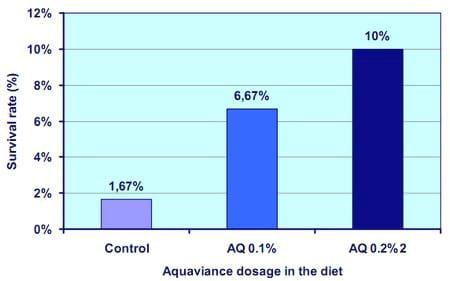
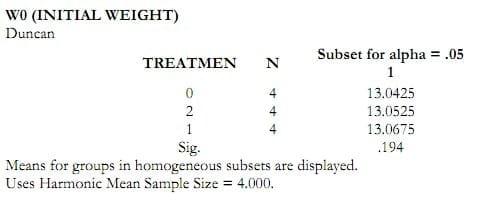
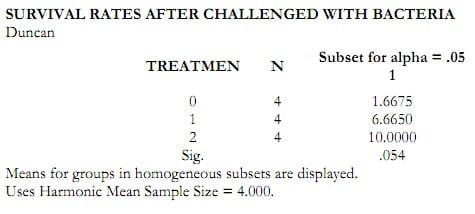
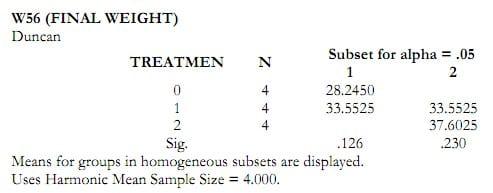
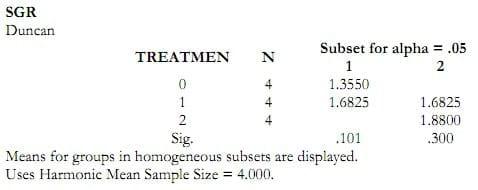
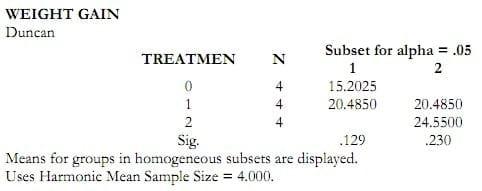
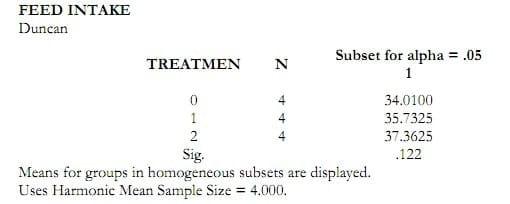
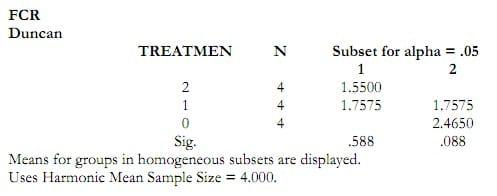











.jpg&w=3840&q=75)